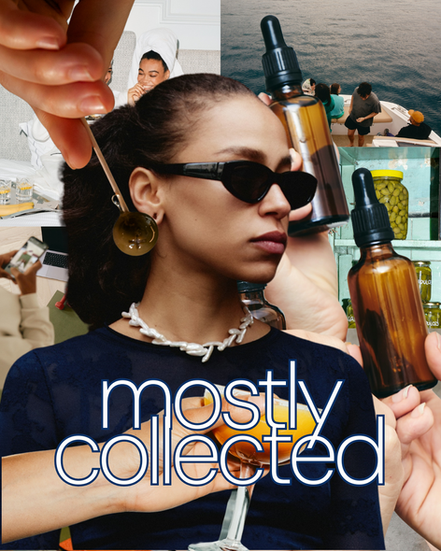Collages in Fashion - The Sims for Brand Marketing??
- arthursbeth
- Jun 6
- 4 min read
Collages have been quietly dominating the social media landscape, not just as aesthetic content, but as a deeper signal of how brands understand their customers. What started as nostalgic moodboarding has evolved into a new language of audience profiling, community building, and trend creation.
But here’s what’s interesting: what used to happen behind closed doors in marketing meetings and uni lectures - the act of customer segmentation and profiling — is now being done out loud.
Collaging ~ Transparent Customer Profiling?
Traditionally, customer profiling like we're seeing has been a backstage activity. Admittedly, a fun one, but marketers would build fictional personas based on data, trends, and assumed behaviours.
These personas are used to:
Improve targeting by aligning campaigns to real customer needs
Enhance personalisation by tailoring tone, content, and product
Foster internal cohesion with a clear, shared vision of the audience

But now? Social teams are building those personas in public.
These brand-created collages - often seen as aesthetic posts, TikTok grids, or Instagram carousels - are essentially public-facing customer profiles. And that’s part of the appeal. Discussing this collaging as a social media trend, Katie Robinson of Refashioned, defines it perfectly as “world-building” what goes on in customer profile development is exactly that.
It's constructing a reality made of coffee orders, flatshares, playlists, routines, and street style. It's literally marketing’s version of The Sims except when done by brands, the audience gets to see themselves in it.
Collages That Listen Back
When brands post these visual profiles on social, it's not just an opportuity to creating trending content, it can test resonance.
If a collage is accurate, followers flock to it. They comment “me,” “I’ve never felt so seen,” “how did you know this was me?” That’s immediate feedback on audience understanding, without a single survey.
This builds a more honest feedback loop. Instead of guessing in a boardroom, brands can now validate their customer vision through social reactions, save rates, and shares, then use that insight to inform product design, influencer partnerships, and editorial direction.
Why Collages Work: They Embrace the Messy Middle
Collages reflect what humans are actually like: non-linear, layered, often contradictory. They push back on overly polished feeds and make space for complexity. That’s why they’ve become such a powerful format in 2024-25:
They capture the messiness of human beings
They signal community and cultural fluency
They respond to the emerging backlash to the “clean aesthetic” towards something more honest, relational, and lived-in
And in a time when authenticity is the most overused word in marketing, collaging lets brands demonstrate it instead of claiming it.
Irigai evidence of a few collage-ing hours v well spent
From Aesthetic to Ecosystem
What makes collage culture so powerful is how multi-dimensional it can be.
You’re not just profiling a person, you’re profiling a scene
You’re not just pushing product, you’re proposing context
You’re not just building content, you’re building culture
As brands lean further into this practice, what emerges isn’t just beautiful moodboards. It’s a living, breathing archive of who your audience is becoming — and how you can grow with them.
Co-Creating Trends
Trends are increasingly starting with creators and micro-communities. There's been a growing shift from top-down to trickle-up influence in fashion, and collages have followed the same trajectory, being Introduced as a new Instagram feature last year, along with growing in popularity on TikTok. The collaborative mood board attributes of Pinterest led to it being used by more fashion brands last year.
This new form of collage content doesn't have to be about aspiration, it’s about reflection. Brands are holding up a mirror to their audiences, showing them the world they created, with their brand as a feature, not the main character.
In a sense, this is community building. It’s not centred around one person or aesthetic ideal, but the intersections of style, humour, taste, and identity.
For sustainable fashion brands, these consumer-centric collages offer a huge opportunity to turn marketing into meaningful co-creation. They can significantly help brands engage consumers in conversations around circularity, promote resale and rental, and build communities grounded in shared values, turning visual storytelling into a strategic tool for real impact.
There's actually interesting research on this; "Co-creating Sustainability: Transformative Power of the Brand", is a study all about how co-creation is an essential element of shift traditional fashion marketing strategies into collaborative, sustainability-driven action.

Collages For President!!
They might just seem a procrastination tactic (guilty btw), but used wisely, collage content isn’t superficial. It’s a way to democratise storytelling, invite collaboration, and make marketing feel more human.
It’s not about manufacturing demand, it’s about recognising identity. And in the age of fragmented attention and over-rehearsed authenticity, that might be one of the most sustainable things a brand can do.
Erm, shall we chat about this??
Whether it's an opinion on the article, or you want to see how we could work together on your creative strategy, we'd love to hear from you.











Comments